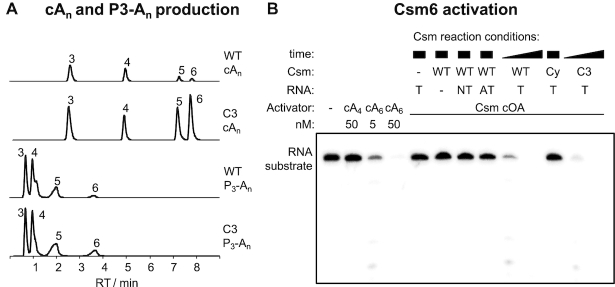Figure 3.
cOA production and Csm6 activation. (A) Extracted ion chromatograms of oligoadenylates produced by WT and Csm3 D35A variant (C3) Csm complex. Identical y-scaling throughout. The identity of the cyclic OAs (cAn) and respective 5′-triphosphates (P3-An) is indicated by the number of AMP subunits. Production of cOAs, cA5 and cA6 in particular, was significantly increased for the Csm3 D35A (C3) Csm complex. (B) Csm6 ribonuclease activation by cyclic oligoadenylates. Mtb Csm6 (125 nM) was incubated with 200 nM 5′-[32P]-substrate RNA at 37°C for 30 min in the presence of synthetic oligoadenylates (cA4, cA6) or a 10-fold dilution of Csm-derived cOAs. Csm WT (800 nM), cyclase variant (Cy, 800 nM) or Csm3 D35A (C3, 200 nM) was incubated with 1 mM ATP and 200 nM target (T), non-target (NT) or anti-tag (AT) RNA for 0.5, 2 (WT, C3), or 90 min (all others) at 30°C. Only cA6 activated Csm6. For WT and C3 Csm, sufficient cA6 was produced within 0.5 min to switch on Csm6 ribonuclease activity; whereas no detectable amount of cA6 was produced under all other conditions even after prolonged reaction time.

